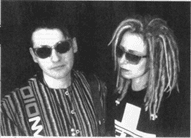From Guitars to Beats - The indie heads who embraced dance music
Wednesday, May 31, 2017
by Tat
It is not unusual for a guitar band or artist to dip their toe into dance music, in the 1970s many artists had flirtations with disco before stepping back to their more traditional sound. Disco and 12 inch mixes became the norm in the 1980s but again many artists used modern dance and remix techniques to reach new audiences. It was the late 1980s and early 1990s when established independent artists really explored the dance music environment wholesale. We thought it would be good at Trackhunter HQ to pick out a few of our favourites.
Norman Cook - AKA Fatboy Slim
Norman Cook is very much known for his posturing, high-octane party DJ and productions under his Fatboy Slim moniker. Whilst it was through the burgeoning indie scene of the mid 1980s when he came to fame as a member of the highly successful indie-pop quartet The Housemartins. He had all of the ingredients as an indie bassist. Tall and gangly with his polo t shirt and shuffling style, Cook formed part of one of the 1980s truly successful UK indie bands. Yet despite all of this Cook had been active as a dance music DJ since the earlier part of 1980s and made a switch away from indie in 1989 when he formed Beats International. Three years earlier he had released a cut and paste 12 inch titled D.J Mega-Mix Volume 1. The electro cut and paste mix in the style of Double Dee and Steinski was as good as anything that was coming out of New York at the same time and showed Cook's passion for creative mixing. Cook followed up with other successful projects, most notably Freak Power and later on with Mighty Dub Katz. His most successful alias came in 1995 via his own Skint Label when he released the brilliant Everyone Needs a 303 under the name Fatboy Slim. This was just the start as the latest iteration of Cook took DJing to a whole new level of performance whilst he enjoyed hit after hit in the music charts with his perfectly honed full on party releases.
The Shamen
The Shamen like The Housemartins appeared in the mid 1980s and at the time when the indie music scene was over-shadowing much of what dance music counterparts could offer. Hip hop was gaining momentum alongside British soul but the airwaves were full of the guitar sound unless you tuned into the likes of John Peel on Radio One or Mike Allen on Capital Radio. The indie scene was spiralling in a multitude of directions and up in Scotland that was very much the case. The foursome had already got a handful of indie and psychedelic rock releases under their belt when their front man Colin Angus started to explore early house music and the UK releases that were mostly starting to appear out of London. Like so many other bands at the time they started to explore sampling and drum machines which in turn changed the whole direction for the band. The idea of a guitar band experimenting with drum machines and samplers was not that new as many industrial and post punk bands had been doing that for some years. The difference with the likes of The Shamen is that their complete transformation into dance music not only changed dance music itself but also opened them up to a totally new audience. In 1988 that commitment to dance music was firmed up as they released 'Transcendental' in collaboration with Chris Westbrook AKA Chicago legend Bam Bam. Yet it was 1991 when they truly set the rave scene alight with their anthem 'Move any Mountain', by then their dance music transformation was done and dusted despite the resonating indie sounds. Shortly after that release they sadly lost Will Sinnott who drowned off the coast of La Gomera. London club personality, MC, DJ and later on club owner Mr C joined the band and in turn saw them have their greatest success with Ebeneezer Goode. The controversial track came at a time when rave was at his height and saw the band go on to have several more chart hits as a dance act.
youtube.com/watch?v=wvlbpezHhsY
GTO - AKA Greater Than One
Industrial music has never been too far away from dance music and with the birth of techno and then rave those three worlds became ever closer. Greater Than One were Lee Newman and Michael Wells and between them they released a stack of industrial and electronic music over the course of a decade. They first appeared in 1985 with their 'Kill the Pedagogue' album on their own label. They continued with their Greater Than One moniker into the early 1990s but it was around that time when they released the seminal rave track 'Pure' under the abridged name of GTO. Pure became an instant dancefloor classic and captured the sounds coming out of Europe that were gaining incredible momentum at the time. Newman and Wells followed up with the superb 'Listen to the Rhythm Flow' and 'Elevation'. At the same time they expanded their portfolio to release under the guises of Church of Extacy, Tricky Disco, John + Julie, Signs of Chaos, among many others. Whilst their releases appeared on the prime labels of that time, XL, Rising High, Warp and React. Newman passed away in 1995 whilst Wells continued to release music into the 21st Century.
youtube.com/watch?v=jKTEXhc6IyY
Primal Scream
Another Scottish indie band who found fame after embracing the house and rave scene that was sweeping across the UK in the late 1990s. Still very much renowned as a psychedelic rock band it was their dance-orientated tracks that brought them to the attention of a wider audience. In 1987 they released their debut album Sonic Flower Groove which retained elements of Bobby Gillespie's previous band Jesus and Mary Chain shoegaze alongside a indie pop innocence and psychedelic groove. It was three years later when Andrew Weatherall got his hands on the mixing desk and produced the euphoric track Loaded after taking a beat from Soul II Soul. The track was an instant hit with the Balearic dance community. Boys Own Terry Farley joined Weatherall in the studio to work on Primal Scream's next album Screamadelica. It was an instant hit within the dance scene as they retained a psychedelic element but opening them up to a whole new audience. Gillespie said that Screamadelica was influenced by the Beach Boys 'Pet Sounds' album released in 1966. Future releases retained that rock, psychedelic blues element as most witnessed in their live performances, but single releases explored the wider boundaries of trance, reggae, big beat among other genres.
youtube.com/watch?v=NwMOpaxroTg
All four artists not only managed to repackage themselves to reach new audiences, but they also retained enough of their original self to deliver something wholly new. The indie dance crossover is bigger than ever and over the last few decades seen whole sub genres appear and disappear. The four artists above all made a huge contribution to dance music and indie music alike, for that we applaud them.
Discover great indie digital music with Trackhunter







